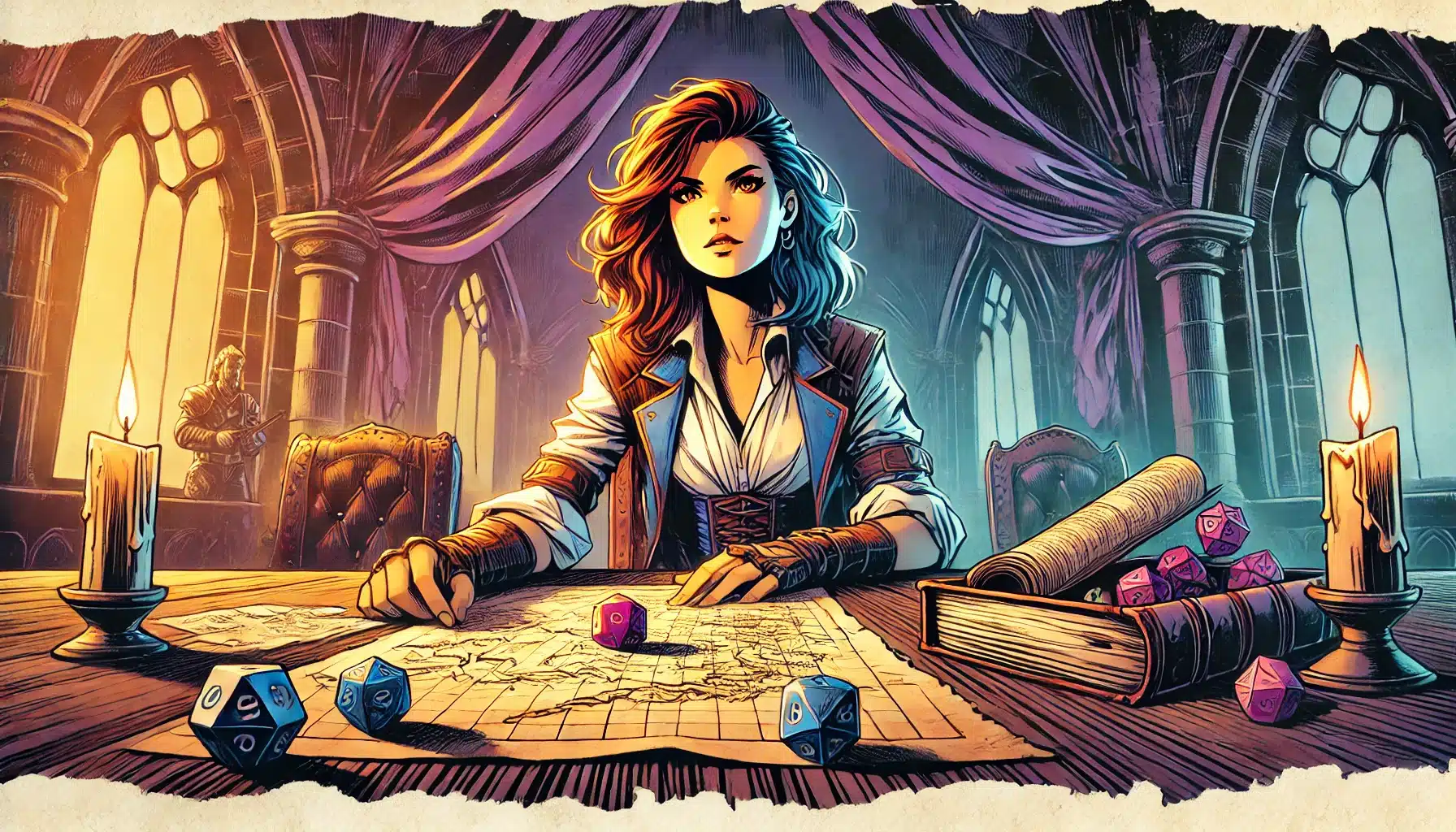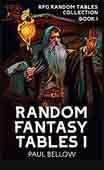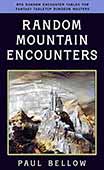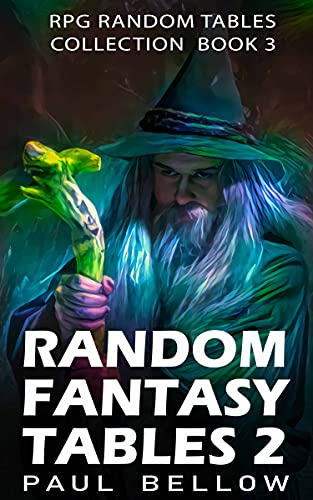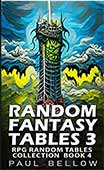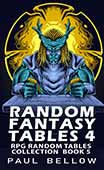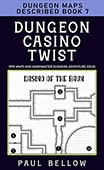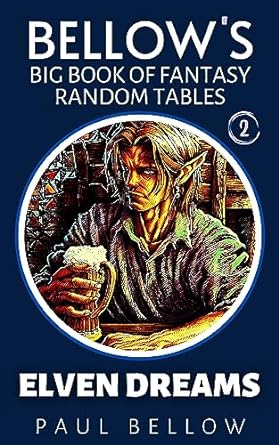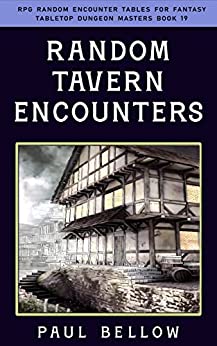In the world of Dungeons & Dragons (D&D), storytelling is the lifeblood that fuels every session, binding players and Dungeon Masters (DMs) alike with the allure of adventure. It’s the delicate art of weaving narrative and player interaction into a tapestry so engaging that players forget their surroundings and become wholly immersed in their characters’ journeys. Imagine this: a well-told story can transform a simple evening of gaming into an unforgettable saga that players recount years later. However, even the most seasoned Dungeon Masters occasionally stumble upon storytelling pitfalls that can jarringly disrupt player engagement and compromise immersion.
Sure, everyone makes mistakes, but it’s essential to recognize that awareness is the first step toward improvement. Even veteran DMs can inadvertently fall into traps like railroading players or overcomplicating narrative threads, leading to frustration and disengagement. But here’s the catch: with careful reflection and practice, these missteps can become lessons, refining a DM’s craft and enhancing the group’s overall experience. Let’s delve into the common storytelling mistakes that, when avoided, can elevate a campaign from a routine dungeon crawl to a veritable masterpiece.
Understanding and addressing these mistakes not only requires dedication but also a willingness to adapt and learn from the dynamics at the table. By shining a light on these frequent storytelling blunders, DMs can not only salvage but reinvigorate their campaigns, ensuring a rewarding creative journey for everyone involved.
Common Storytelling Mistakes in D&D
A well-crafted narrative is more than just a sequence of events; it’s the backbone of any successful D&D campaign, essential for fostering player immersion and ensuring campaign success. When players sit around the table, dice in hand, they aren’t just seeking a game but rather an emotional journey—a story that grips their imagination and invites them to explore its depths. In such a setting, strong narratives cultivate emotional investment, transforming characters into beloved avatars with personal stakes.
But what is it about storytelling that holds such intrinsic power over player engagement? For one, stories provide context and meaning to player actions, turning abstract mechanics into a living, breathing world where actions have consequences. A well-told tale can evoke a wide range of emotions, from triumph and fear to wonder and mystery, engaging players on multiple levels and making them eager participants rather than passive spectators.
Strong narratives also act as a catalyst for collaboration between players and the DM, encouraging teamwork and shared problem-solving as the story unfolds. In many ways, D&D storytelling mirrors the collaborative nature of improvisational theatre, where each participant’s contribution shapes the evolving plot. This communal aspect not only enhances camaraderie but also deepens the players’ collective memory of their in-game adventures.
Try my AI Tabletop RPG generators...and an extensive library of content!
However, the flip side of this engaging dynamic is that it can be easily disrupted by storytelling missteps. Whether it’s through lack of narrative cohesion, or by failing to recognize player agency, such errors can turn an otherwise captivating tale into a tedious or frustrating experience. Therefore, understanding the significance of storytelling in D&D and the pitfalls to avoid is crucial for any DM aspiring to craft memorable campaigns.
Railroading the Players
One of the most common storytelling pitfalls encountered by DMs is the phenomenon known as “railroading”. This occurs when players are forced down a predetermined path, stripping them of agency and spontaneity—a dynamic akin to being passengers on an inflexible, predestined train. Imagine embarking on an epic journey only to find there’s no room for personal choices—all roads lead to the same inevitable conclusion. When players sense that their decisions lack impact, immersion crumbles, as they no longer feel like active participants in shaping the tale.
It’s important to distinguish between guiding players—offering gentle nudges toward plot progression—and overt railroading, which disregards player choices altogether. An engaging narrative invites players to explore and interact freely, with the DM facilitating rather than dictating the course of events. The delicate balance lies in guiding players while leaving room for creative twists brought on by their actions, ensuring a dynamic and organic storytelling experience.
So, how can DMs spot the signs of railroading and circumvent this narrative snag? Here are some telltale signs and effective strategies to keep the story on the right tracks:
⚔️ Fantasy RPG Random Tables Books
Make life as a Gamemaster easier…
If you play Dungeons & Dragons, Pathfinder, or other fantasy RPGs, this
RPG random tables series
is packed with encounters, NPCs, treasure, and more. Available in eBook or print—either way, you’ll have a wealth of adventure ideas at your fingertips.
- Predictable Outcomes: If players can consistently foresee the story’s outcome regardless of their actions, it hints at potential railroading.
- Dismissal of Player Ideas: Ignoring or discouraging player-led solutions can stifle creativity and engagement.
- Scripting Characters’ Dialogue: Allow flexibility in NPCs’ responses to maintain the illusion of a living world.
- Ignoring Player Inputs: Failing to integrate players’ suggestions or backstories into the narrative can diminish investment.
- Forcing Set-Piece Battles: Adapting encounters based on player choices can foster unique experiences.
- Rigid Plot Structure: Introducing branching storylines encourages player agency.
- Overbearing NPC Guides: NPCs should enhance, not overshadow, player decisions.
- Inescapable Locations: Providing multiple routes and solutions keeps exploration fresh.
- Black and White Choices: Nuance and complexity in decisions can enhance storytelling depth.
- Predictable Plot Twists: Keeping players guessing with well-timed surprises sustains engagement.
Ultimately, avoiding the railroading trap requires DMs to maintain a flexible and adaptive mindset, embracing the collective creativity at the table. Recognizing and empowering player agency doesn’t just preserve immersion; it elevates the entire campaign into an exhilarating shared adventure.
By allowing stories to unfold organically and weaving player actions into the narrative fabric, DMs can ensure that each session becomes a collaborative creation—a masterpiece born of shared imagination and discovery.
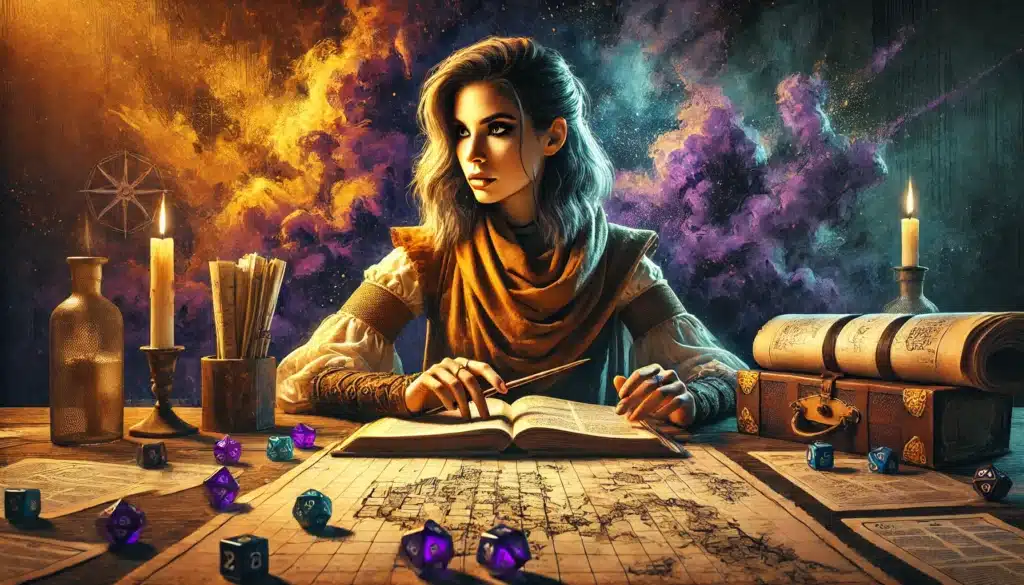
Overcomplicating the Narrative
There’s an allure in crafting a deep, intricate world with layer upon layer of lore and plot threads, but herein lies the pitfall of overcomplicating the narrative. This inclination, while well-intentioned, can often bog down games, confuse players, and impede the natural flow of storytelling. Imagine being a player faced with convoluted plots, an avalanche of backstory data, and a plethora of NPCs with intertwined agendas—it quickly becomes overwhelming.
The challenge lies in balancing detail with clarity. Excessive complexity can obscure core storylines, making it hard for players to discern their objective or role within the tale. A DM’s task, then, is to distill vast narratives into digestible pieces, prioritizing essential elements that propel the story forward while providing enough allure to stir curiosity.
Simplifying doesn’t mean sacrificing depth. Instead, focus on character-driven conflicts, revealing information in increments, and anchoring plots around recurring themes. A streamlined narrative invites players to connect emotionally and intellectually, rather than leaving them tangled in an incomprehensible web of events.
Let’s explore some strategies to maintain clarity without losing narrative richness:
- Limit Lore Dumps: Introduce world details gradually, as players uncover them through exploration.
- Use Recurring NPCs: Familiar faces aid continuity and lessen confusion.
- Character-Centric Stories: Focus plots around players’ backstories and goals.
- Gradual World-Building: Expand lore organically through player actions and discoveries.
- Distinctive Plot Hooks: Clear, compelling goals motivate players and provide structure.
- Avoiding Overloaded Scenes: Simplicity in description enhances player focus.
- Emphasize Core Themes: Themes provide coherence and direction amidst complexity.
- Timeline Management: Maintain chronological clarity to aid plot comprehension.
- Multiple Threads Require Caution: Limit concurrent plotlines to avoid overwhelming players.
- Prioritize Engaging Conflicts: Interesting dilemmas over minor details make for memorable sessions.
By aligning depth with digestibility, DMs can craft narratives that entice without ensnaring. A well-managed complexity invites players to engage with enthusiasm, immersing them in a story that feels both grand and intimately accessible.
Ultimately, the key to a successful narrative lies in its balance—the artful dance between intriguing depth and engaging clarity, ensuring each session unfolds as an enjoyable journey through the shared landscape of imagination.
Ignoring Player Backstories
A narrative mistake that often goes unnoticed is the neglect of player backstories. These personal histories are not just idle details; they are the anchors of character motivation, providing depth and a unique lens through which players view the unfolding world. Failing to integrate player backstories can lead to a sense of disconnect, as players may feel their characters lack narrative significance in the broader story.
By weaving player backstories into the campaign, DMs create windows of opportunity for deeper character development and engagement. Imagine a warrior’s quest entwined with the campaign’s central conflict, or a sorcerer discovering ties to a long-lost magical lineage. When players see their personal stories intersecting with the campaign’s main arc, the experience transforms from a generic adventure into a personal odyssey.
Integrating backstories requires thoughtful consideration and a willingness to adapt the plot to accommodate player contributions. This means creating narratives with the flexibility to incorporate individual character goals, fears, or unresolved conflicts, thus inviting players to become co-authors of the collective tale.
Here’s a table to illustrate potential backstory integrations and their narrative impacts:
| Player Backstory Element | Campaign Incorporation | Narrative Impact |
|---|---|---|
| Family Vengeance Quest | BBEG related to the PC’s family | Personal stake in defeating the villain |
| Lost Artifact | Quest hook for a powerful, ancient relic | Builds investment in world lore |
| Old Rivalry or Grudge | Rivals appear as recurring antagonists | Adds tension and suspense |
| Secret Heritage | Discovering PC’s royal/magical lineage | Offers personal transformation arcs |
| Mentor’s Tragic Demise | NPCs tying into PC’s past appear in storyline | Fosters emotional engagement and personal growth |
The key is to let player backgrounds inform the story without overshadowing group dynamics. Balance between individual arcs and collective goals remains vital to harmonious gameplay. When DMs successfully harness player backstories, campaigns become enriched tapestries that resonate personally for each participant.
⚔️ Fantasy RPG Random Tables Books
Make life as a Gamemaster easier…
If you play Dungeons & Dragons, Pathfinder, or other fantasy RPGs, this
RPG random tables series
is packed with encounters, NPCs, treasure, and more. Available in eBook or print—either way, you’ll have a wealth of adventure ideas at your fingertips.
A dynamic integration of backstories fosters a richer, more cohesive narrative where each player feels their character truly matters in shaping the adventure’s unfolding legacy.
Pacing Issues in the Story
Pacing is the rhythm of storytelling; it’s the tempo that blends action, roleplay, and downtime, threading them into a seamless narrative fabric. Poor pacing can turn a session into a monotonous trudge or induce whiplash from rapid, disjointed transitions. Imagine the urgency of a cliffhanger squandered because downtime stretched too long, or roleplay opportunities smothered under incessant combat—these are the symptoms of a pacing hiccup.
Balancing pacing involves modulation, often dictated by the story’s unfolding events. A well-paced campaign knows when to accelerate and when to stand still, providing moments for strategic planning and reflection or high-stakes action that gets the adrenaline pumping. The allure lies in creating distinct peaks and valleys that maintain engagement without exhaustion.
As a DM, ensuring good pacing also demands sensitivity to the group’s energy. Some players thrive on character interaction, while others hunger for tactical encounters. Recognizing these preferences enables the DM to prioritize elements that keep the story’s momentum fluid and engaging without alienating any party members.
Here are some strategies to enhance pacing in your campaign:
- Incorporate Cliffhangers: Ending sessions on suspense fuels enthusiasm for the next game.
- High and Low Tension: Alternate between intense action and calm for dynamic gameplay.
- Varied Scene Lengths: Balancing lengthy explorations with brisk, energetic skirmishes enhances rhythm.
- Utilize In-Game Calendars: Managing time within the game world creates healthy narrative progression.
- Player-Driven Sessions: Adapt pacing based on player cues and interests.
- Regular Check-Ins: Gauge energy levels to maintain a satisfying pace.
- Conflict Resolution Timing: Resolve critical arcs at strategic points to sustain interest.
- Narrative Breathers: Allow for character development scenes to balance explosive events.
- Balancing Combat and Story: Equally value narrative exposition and thrilling encounters for harmonious flow.
- Minimal Downtime between Scenes: Minimize lulls and keep transitions smooth to sustain momentum.
By cultivating a keen sense of timing and flow, DMs can create a balanced narrative where excitement and intrigue keep players consistently engaged, enhancing each session’s revelatory nature.
Good pacing is not just about restraint; it’s an opportunity to orchestrate the unfolding drama so players are swept up in a cadence that feels both natural and exhilarating.
Forgetting to Foreshadow
The art of foreshadowing is a subtle but powerful storytelling tool, setting the stage for future revelations and lending a sense of continuity and depth to the narrative. When done well, foreshadowing tantalizes players, feeding their curiosity with hints and promises that build anticipation for what’s to come. But when neglected, plot developments can feel jarring and unearned, leaving players detached from the story’s course.
It’s the subtle art of hiding clues in plain sight, allowing players to reflect back on earlier events with newfound understanding. Imagine a campaign where the presence of a mysterious symbol in an opening scene later reveals itself as crucial to the climax. Foreshadowing cultivates a complex narrative tapestry, weaving seemingly unrelated events into a cohesive story fabric.
To master foreshadowing, DMs must recognize it as both an art form and an exercise in memory. It requires a balance of subtlety and clarity, ensuring players feel clever for connecting the dots without feeling spoon-fed. Strategic placement of hints and clues throughout sessions can elevate storytelling from linear progression to an intricate puzzle that players strive to solve.
Here are techniques for effective foreshadowing:
- Environmental Storytelling: Subtle world details hinting at larger truths.
- NPC Dialogue Hints: Conversations dropping underlying truths without overt explanations.
- Recurring Symbols: Subtle motifs building connection to major revelations.
- Prophecies and Portents: Old legends with double meanings predicting future events.
- Dream Sequences: Surreal hints at future conflicts during vulnerable character moments.
- Misinformation: Successfully misleading information later clarified adds depth.
- Indirect References: Linking seemingly minor events to upcoming challenges.
- Echoing Themes: Resurfacing core themes weave continuity through plot twists.
- Past Event Callbacks: Referencing earlier events in predictive hindsight.
- Strategic Silence: What’s unsaid sparking player curiosity and speculation.
Through inventive use of foreshadowing, a narrative gains complexity and intrigue, pulling players ever deeper into its unfolding mysteries. By planting the seeds early, DMs can reward attentive players with the satisfaction of unraveling the hidden threads lying beneath their adventures.
By integrating foreshadowing, DMs preserve narrative tension and momentum, ensuring future plot twists feel-earned and enchantingly inevitable.
One-Dimensional Villains
Villains are the catalysts for adventure; they ignite the call to arms and challenge players to rise as heroes. Yet, one of the most significant storytelling pitfalls is crafting one-dimensional villains—those lacking complexity, motivation, or depth. Imagine opposing a villain who is evil simply for the sake of it, without any meaningful motivations or nuance; such a character becomes forgettable and fails to inspire the critical engagement necessary for a compelling narrative.
Crafting a multifaceted antagonist bridges the gap between mere obstacles and truly memorable storytelling. A well-developed villain has clear motivations, perhaps even justifications for their actions, that players can understand if not sympathize with. This depth prompts players to question their own actions and objectives, advancing narrative intrigue and complexity.
Questionably honorable or sympathetically unreasonable, layered villains add an emotional charge to the story, fostering personal stakes as players engage with the narrative on more than a surface level. A truly memorable antagonist challenges not only the characters but the players themselves, evoking reflection and debate.
To illustrate varying villain archetypes and their narrative strengths, consider this table:
| Villain Archetype | Strengths of Archetype | Story Enhancement |
|---|---|---|
| The Tragic Antihero | Humanized motivations, moral ambiguity | Invites players to explore ethical dilemmas |
| The Charismatic Leader | Inspires loyalty, deceives players | Fosters complex social dynamics |
| The Mad Scientist | Obsession-driven genius with twisted visions | Enhances plot with unpredictable innovations |
| The Fallen Hero | Motivated by loss or betrayal | Emotional resonance through shared experiences |
| The Impersonal Menace | Monumental, existential threat | Drives urgency, self-preservation instinct |
| The Shadow Manipulator | Deceptive puppet master pulling hidden strings | Engages players in unraveling intricate plots |
By embracing diverse villain archetypes, a DM not only enriches the story but also encourages players to interact with the narrative on multiple levels. These interactions are where true character development lies—in grappling with opponents holding the mirror to the heroes’ own values and convictions.
Try my AI Tabletop RPG generators...and an extensive library of content!
Crafting complex antagonists not only provides motivation and depth to the plot; they transform conflicts into captivating stories where the lines between good and evil are blurred and players must determine their own definitions of justice and morality.
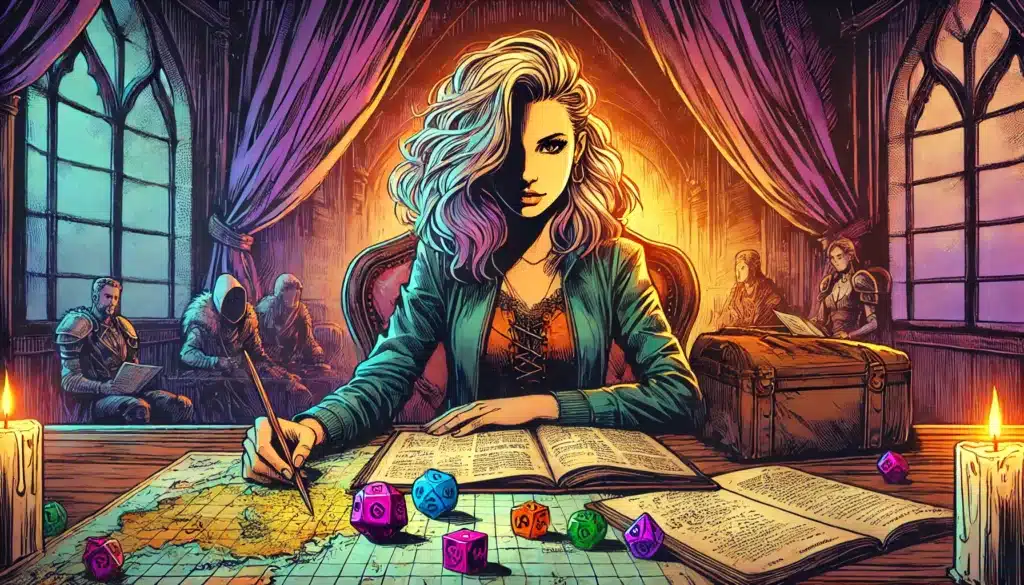
Neglecting Player Choice Consequences
One of the strongest narrative freedoms D&D offers is the impact of player choices. These decisions should reverberate throughout the campaign world, shaping the storyline and cementing players as integral architects of the narrative. Yet neglecting to reflect these choices in-game can render the experience static, ultimately disengaging players. When characters’ actions carry palpable consequences, however, they transform the narrative landscape and infuse campaigns with vitality and realism.
Imagine inhabiting a world where every player choice impacts the outcome: past deeds attract allies or incur rivals; political landscapes shift; unique quest lines unfold, unlocked by prior actions. Here lies the crux—acknowledging player agency lies at the heart of great storytelling in D&D.
To sustain a dynamic and responsive campaign world, embrace the following examples:
- NPC Reactions: Changed attitudes reflecting past interactions.
- Altering Political Dynamics: Decisions influencing alliances, power structures.
- Environmental Impacts: Player actions affecting physical or ecological changes.
- Evolving Quest Lines: Different outcomes, branching paths after pivotal decisions.
- Leveraging Favors or Debts: Bartering past deeds for future advantages.
- NPC Development: Allies and enemies grow based on player actions.
- Invisible Tensions: Subtle repercussions surfacing later in unexpected ways.
- Resource Scarcity: Decisions impacting the abundance or scarcity of vital supplies.
- Unlocking Unique Lore: Prior choices revealing hidden knowledge, secrets.
Emphasizing the consequences of player actions enriches collaborative storytelling, whether through dramatic revelations, subtle ripples, or cascading changes. This responsive world-building initiates an ever-evolving gameplay experience where players witness the unfolding of unique stories etched by their characters’ choices.
Celebrating player agency invites a shared discovery between DM and players—a journey where actions ripple through the narrative, creating a dynamic world alive with possibility and consequence.
Fixing Storytelling Mistakes for Better Campaigns
Improving storytelling doesn’t just elevate the game; it transforms the entire player experience. A well-told story magnetizes player attention, instilling campaigns with layers of unforgettable discovery. Imagine sessions that linger in memory, cherished for their shared emotional investment and intricate plots—a result of thoughtful narrative engagement and careful alignment with player interests.
Strong storytelling not only captivates and entertains but fosters community and collaboration. By prioritizing compelling narratives and fluid story arcs, DMs can dismantle disengagement, unlocking a new depth of collective creativity at the gaming table. With knowledge of common storytelling pitfalls, DMs gain the insight necessary to refine their craft, transcending barriers and elevating game nights to legendary status.
But the transformative journey doesn’t stop there. Embracing flexibility and player feedback encourages DMs to explore diverse narrative techniques and styles, paving the way for continual improvement. By honing storytelling skills through open-minded exploration, DMs can cultivate campaigns that leave lasting impressions, where every session invokes excitement and anticipation for the next.
Learning from Player Feedback
The path to enhanced storytelling is illuminated by the feedback of players, whose observations and suggestions provide a vital window into their engagement and enjoyment. Embracing feedback effectively requires proactive solicitation and genuine openness to adapting narrative techniques. After all, players are the pulse of the campaign—they furnish insight into what resonates, what challenges, and what captivates.
⚔️ Fantasy RPG Random Tables Books
Make life as a Gamemaster easier…
If you play Dungeons & Dragons, Pathfinder, or other fantasy RPGs, this
RPG random tables series
is packed with encounters, NPCs, treasure, and more. Available in eBook or print—either way, you’ll have a wealth of adventure ideas at your fingertips.
Nurturing an environment where feedback feels valued and welcome is paramount. Meaningful feedback goes beyond soliciting opinions; it requires active listening, comprehension, and the willingness to integrate suggestions thoughtfully into future sessions. Remember, each player offers a unique perspective, and by opening a dialogue and encouraging participation, DMs can better align game dynamics with the group’s aspirations.
Consider these strategies for gathering and implementing player feedback:
- Post-Session Discussions: Open forums shortly after sessions to gauge immediate reactions.
- Anonymous Surveys: Online surveys offering anonymity may yield candid responses.
- In-Character Check-Ins: Personal interviews allow players to voice both in-character and out-of-character experiences.
- Focused Feedback Rounds: Highlight specific narrative elements for guided critique.
- One-on-One Conversations: Personal discussions to understand individual player stories and experiences.
- Player-Led Story Ideas: Encourage players to contribute ideas; involved players feel invested.
- Retrospectives: Reflective sessions tracing story arcs and collective experiences.
- Observing Player Reactions: Note emotive responses to various scenarios during gameplay.
- Collective Votes on Plot Elements: Group consensus on pivotal decisions shapes the tale.
- Feedback Loop Updates: Regular updates on which suggestions have been considered or incorporated.
Incorporating player feedback is a journey of collaboration and mutual growth. As DMs embrace feedback with open arms and genuine curiosity, they strengthen the campaign’s narrative, collectively guiding it toward a dynamic and rewarding destination.
Fostering a responsive storytelling environment isn’t just a boon for player satisfaction; it catalyzes DMs’ evolution, perpetually enriching each campaign with the collective genius of all contributing voices.
Experimenting with Different Narrative Styles
D&D is a game of boundless creativity, where different narrative styles can invigorate campaigns with fresh perspectives and originality. Stepping into new narrative realms challenges DMs to stretch their storytelling muscles, exploring uncharted approaches and unlocking unforeseen storytelling potential. Whether you prefer a wide-open sandbox or a focused linear plot, mixing new styles keeps your campaign fresh for both you and your players.
Experimentation invites adaptability, encouraging DMs to tailor story experiences according to campaign goals and player preferences. By venturing into novel narrative territories, DMs can hone their craft, discover new facets of storytelling, and invigorate players’ enthusiasm for the campaign world.
To assist in navigating varying narrative styles, let’s consider a comparative table:
| Narrative Style | Pros | Cons |
|---|---|---|
| Sandbox | Player-driven exploration and agency | Risk of directionless sessions |
| Linear | Strong focus on cohesive story progression | Limited player freedom and flexibility |
| Mystery-Driven | Engages critical thinking and puzzle-solving | Complexity may stall narrative flow |
| Episodic | Self-contained arcs enhance variety | May lack overarching continuity |
| Character-Focused | Deep personal development opportunities | Risk of sidelining group-wide narrative |
While breaking out of your comfort zone may feel challenging, it’s a crucial part of exploring diverse storytelling dimensions. Each approach yields different experiences and insights, offering new creative pathways for immersion and engagement. Thus, DMs who venture beyond their usual toolkit enrich the tapestry of potential campaign stories.
Embracing diverse narrative forms heightens storytelling potential, fostering dynamic adventure campaigns that consistently intrigue, excite, and captivate players.
So why not explore eclectic styles and cultivate new flavors of storytelling magic? You may just unlock unforeseen vistas of collective creativity in your campaign world.
Using Tools to Enhance Storytelling
Harnessing a variety of tools can significantly enhance the art and craft of D&D storytelling, transforming preparation, execution, and narrative integration into seamless experiences. Both digital and physical resources offer practical and innovative solutions, assisting DMs in organizing plots, tracking player progress, and refining the unfolding story. As such, leveraging these tools can elevate storytelling to a professional level, enhancing the campaign’s richness and coherence.
Digital tools can streamline world-building, session management, and narrative documentation, empowering DMs to manage complex story elements with ease. However, physical tools should not be overlooked; tangible maps, props, or handcrafted visuals spark imagination and engage players in unique ways.
Here are some invaluable tools to enrich your storytelling arsenal:
- Interactive World-Building Software: Programs that offer map creation and character organization.
- Narrative Tracking Applications: Track story arcs, character progression, and world events.
- Session Recap Logs: Secure collective memories and guide future sessions through detailed summaries.
- Improv Techniques: Structured exercises for impromptu storytelling and spontaneous NPC creation.
- Online Plot Generators: Use AI for brainstorming new plotlines or twists.
- Dice Rolling Apps: Manage mechanics and streamline combat encounters digitally.
- Digital Tabletop Simulators: Virtual environments provide dynamic gaming spaces.
- Physical Props and Props: Items that reflect the story world ignite creativity and immersion.
- Random Event Decks: Cards prompting unexpected encounters maintain narrative spontaneity.
- Mood-Enhancing Music or Sound Effects: Audio ambiance enriches the emotional atmosphere of scenes.
Harnessing these tools positions DMs to creatively and effectively craft compelling stories, allowing for smooth navigation through the complexities of campaign management. Whether through digital innovation or tactile ingenuity, each tool bridges the gap to a more efficient, imaginative, and engaging storytelling experience.
Opportunities are boundless for those who embrace the storytelling possibilities these tools unlock, transforming good campaigns into unforgettable sagas sung by players long after the final die is cast.
Final Thoughts on Mastering D&D Storytelling
D&D storytelling is a delicate but thrilling dance, orchestrating narrative arcs that span epic conflicts, intertwining tales, and character journeys. Yet, mastering this art involves an astute awareness of common pitfalls and a commitment to continuous narrative refinement. By sidestepping storytelling mistakes, DMs can cultivate campaigns that transcend ordinary games, creating experiences players reminisce about for years.
The magic of a great campaign lies in engagement—where players’ imaginations and emotions intertwine seamlessly with the fictional world. Prioritizing player engagement means valuing their input, fostering siloed connections between individual stories and group dynamics, and harmonizing those efforts in the quest for collective discovery.
Improvisation rightly assumes a role as the lifeblood of vibrant storytelling, empowering DMs to fluidly adapt narrative threads to suit the novel and unexpected. As DMs strive to improve their craft, they can enhance their storytelling by inviting flexibility into every session, seamlessly integrating player choices with developmental twists.
Ultimately, refining storytelling skills involves commitment to your own creative growth. Players provide fertile ground for developing narrative techniques—feedback offering the compass that guides a DM’s improvement. DMs who maintain an openness to evolving approaches can transform their campaigns and explore new ways to enrich and enliven the game.
At this crossroads, consider the potential and possibility before you. By committing to honing your storytelling abilities, you embark on a journey of your own, exploring the labyrinthine paths of narrative ingenuity. Transforming a good campaign into a great one only requires embracing adaptability, fostering creativity, and writing stories capable of igniting your players’ imaginations—and your own.

